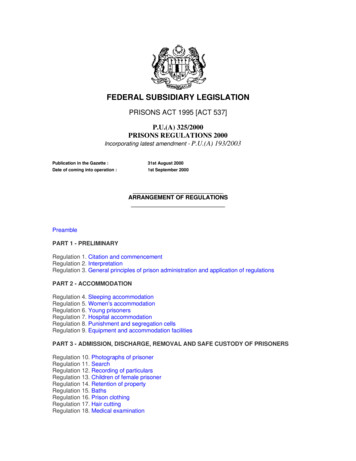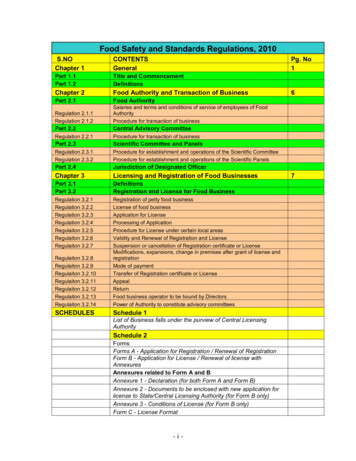
Transcription
1INSURANCE REGULATION IN ZIMBABWE: IS IT ANENABLER OR BURDEN TO THE SECTOR?MUNYARADZI MACHINJIKAActing Head-Insurance and MicroinsuranceINSURANCE AND PENSIONS COMMISSION
Outline Definition of Insurance Regulation Methods of Regulation of Insurance Why is Insurance regulation needed? Any alternatives to Regulation or other forms of intervention? Barriers against adoption of other forms of intervention Regulation Instruments of Regulation Industry Challenges& Regulatory interventions? Emerging Best Practises in Insurance Regulation Conclusion2
Definition of Insurance Regulation3 The National Association of Insurance Commissionersof United States refers to insurance regulation asthat part of state regulation that protects consumersby ensuring that insurers meet their contractualpromises through various requirements such as insurerlicensing, broker licensing, insurance policyregulation, financial regulation, market conduct, andconsumer protection services.
Methods of Regulating Insurance Companies4 StateregulationRefers to situations where the government enacts enablingAct of parliament resulting in a statutory agent or authority toregulate the sector .The Insurance and PensionsCommission (IPEC) was created in the year 2000 throughInsurance and Pension Commission Act (Chapter 24:21)IPEC prosecutes its mandate through the Insurance Act24;07 and Pensions and Provident Fund Act 24:09 but mayalso derive subsidiary legislation through regulation (throughthe Minister of Finance and Economic Development), andthe Commissioner of Insurance and Pensions may issueguidelines, circulars or directives to guide the industryfurther.
Regulation through Judiciary System5Judiciary systemRejda (2009) argues that court judgements aresignificant as they examine the constitutionalityof insurance legislation, interpretation ofinsurance contracts, the legality of actions of thestate regulatory agency thus shaping the entireindustry i.e Magistrate Court, Labour Court, CivilCourt, High Court, Supreme Court and theConstitutional court.
Self-Regulation (Industry Professional Bodies)6Self-regulationApplies industry voluntarily agree in Memorandaof agreements to implement mutually agreedprofessional best ethics, practice and standards.These are at best gentleman’s agreements andnon-binding involving players of the same tradeeg ICZ,ZAFA,LOA,ZAPF
Why is Insurance regulation needed?7Many scholars believe that insurancecompanies must be regulated to protect theinsurance customers in society. Given thatinsurance policies are take-it-or-leave-itcontracts drafted by insurers (contracts ofadhesion), this magnifies the pivotal role thatinsurance regulators must play in protecting andpromoting policyholder interests throughout theexistence and demise of insurers.
Why is Insurance regulation needed? (contd)81.The existence of market failures and precedents ofprejudice to society Economists as noted by Spulber (1989); Viscusi,Vernon and Harrington (2000)cite the presence ofmarket failures such as economic crisis as thefoundation that justifies regulation.Examples:A total of forty-two (42) insurancecompanies were closed post-dollarization in the period2009 to July 2017-(21) were brokers, (13) were nonlife insurance companies, (3) were life companies, (3)were reinsurers whilst (2) were funeral assurancecompanies.
Why is Insurance regulation needed? (contd)92. To address market irrationality by firms and membersof the publicStiglitz noted that the irrational actions of anindividual or a firm may have knock-on effects onsociety .A person might not save enough forretirement and therefore governments haveintroduced compulsory basic pension funds egNational Social Security Scheme in Zimbabwe,price regulations to tame unjustified profits byfirms e.g health insurance such as the greatObamacare in the USA in 2009.
Why is Insurance regulation needed? (contd)103. To compensate for inadequate insurance consumer knowledge Rejda (2011) concludes that insurancecontracts are legal documents with complexterms, conditions, warranties and provisions.There is a massive knowledge imbalance infavour of the insurance company which mightoffer too restrictive and legalistic policies to thedisadvantage of society. There is need to guardagainst unscrupulous agents and brokers frommisleading the public eg promising loans if onebuys insurance.
11Why is Insurance regulation needed?(contd)4. To address supply-side challenges Government may want to improve theavailability of insurance which the market mayfind economically unviable because ofunavailability of information, inadequate pricesand a history e.g. India where InsuranceRegulatory and Development Authority (IRDA)requires life insurers to hold at least 9% of allpolicies to be rural insurance otherwisepenalties will be applied by the regulator. Ensuring financial inclusion-Microinsurance
Why is Insurance regulation needed? (contd)125.Fostering public safety on innocent thirdparties and society at large. In Zimbabwe, the Road Traffic Act Chapter13:11 requires all motor vehicles to have aminimum third-party cover, all publictransporters must have passenger liabilitycover and a certificate of fitness from theCentral Vehicle Inspectorate Directorate (VID).
Why is Insurance regulation needed? (contd)136. To boost public confidence in the Sector Insurer insolvencies may spill beyondpolicyholders to other creditors. Examples thatquickly come to mind include mortgageproviders, banking fraternity, hire-purchaseshops, government departments
Any alternatives to Regulation or other formsof intervention?14 Some researchers posit that regulation can besubstituted at lower costs through imposingcommensurate taxes and subsidies e.g ifgreenhouse gases cause global warming andsmoking is an undesirable social cost, thenprohibitive taxes may be levied .But research by other scholars boldly provedthat such alternatives were insufficient tosubstitute regulation due to the followingchallenges:
Barriers against adoption of otherforms of intervention Regulation15Pricing and Quantifiability ComplicationsResearchers have observed that not all marketmalpractices are easily quantified through pricecomputations such as: terrorism activities ,anticompetitive practices, greenhouse gas emissions. Imperfectinformation and curateinformation and contracting which may be difficultand complex to get.
Instruments of Regulation161.Use of disclosure requirements to theinsurance customersRegulatory requirements for improvedaccessibility to information lead to moreefficient resource allocations e.g mandatorypublication of audited financials in the newInsurance bill, public display of financials onnotice boards, annual reports etc
17Instruments ofRegulation(cont’d)2.Use of mandatesThis refers to instances where the governmentgives certain rights to the firm in exchanges forresponsibilities eg The Zimbabwean government,through the National Social Security Authority Actof 1989 [Chapter 17: 04] (NSSA Act), provided formandatory subscription by all employees for theprovision of minimum pensions and the AccidentPrevention and Workers Compensation Schemewhich insurers all employees in hazardous jobs
18Instruments of Regulation(cont’d)3.Imposing a direct ban (proscriptions)insurance conduct and practicesGovernment out- rightly bans certain marketbehaviours. In terms of the Insurance act,thau shall not trade without a license, allassets of insurers must be invested inZimbabwe and assets pledged as capitalmust be registered in the name of theinsurance company
19Instruments of Regulation(cont’d)4.Imposing ownership limitsThis refers to governments’ efforts inrestricting anti-competitive tendencies andactions in society. In terms of section 4(b) ofStatutory Instrument 59 of 2005 read inconjunction with the Insurance Act 24;09, noindividual or individual may own or controlmore than 40% of the voting shares of aninsurance company
What are the key ingredients of InsuranceRegulation?20Insurance regulation involves various aspects :1.Solvency Regulation(SR)Brown and Klein (2015, p 241)” defines SR as that which: seeksto reduce the risk that an insurer will be unable to meet itsfinancial obligations due to financial distress or bankruptcy and topromote confidence in the financial stability of the insurancesector”. Without regulation, it is difficult for ordinary policy owners tomonitor the financial soundness of insurers. Chandler (1999)and Hunter (2005) argued that solvency regulation was at theheart of insurance regulation.The underlying aim was makingsure the policyholders can claim and be paid on demand infuture
What are the key ingredients ofInsurance Regulation?(cont’d)212.Market conduct regulation Klein (2011) defined market conduct regulation as thatwhich covers market practices such as productdesign, marketing strategies and claims adjustment.Abusive business practices of insurers and agentsneed to be managed through regulation requirementsabout policies offered, fair claims settlement andadequate disclosures. The industry has taken steps to mitigate marketconduct problems through self-compliance measuresand the establishment of a voluntary self-regulatoryorganisation (SRO)
What are the key ingredients ofInsurance Regulation?(cont’d)223.Price and product regulation According to Regan, Tennyson and Weiss (2009), thetwin objectives for nations in regulating insuranceprices are to ensure affordability and availability ofinsurance cover although the traditional motive wasprice adequacy, commensurate and nondiscriminatory premiums. Selten(1975) argues that‘adequate’ rates, shields the insurance sector fromunderpricing which may collapse the more rationalplayers and the entire insurance system.
What are the key ingredients ofInsurance Regulation?(cont’d)234.Disclosure requirements to the insuring public According to Munch and Smallwood (1980), one bigindicator of market failures in the insurance sectorwas information asymmetry (one party to theinsurance contract having more information than theother).Regulators endeavour to correct this irements such as scheduled publication ofaudited and unaudited financials,quarterly reports
Industry Challenges& Regulatoryinterventions?24
Insurance Industry Challenges &Regulatory Interventions by IPECChallenge1.Poor corporategovernance nance Riskmanagementguidelines2.Low insurance Introductionofpenetration rate egulatory capitalcapacity4.High premium ines in place2 licensed microinsurersS.I 95 of 2017S.I 95 of 201725
Insurance Industry Challenges &Regulatory Interventions by delinesEmpowered public, easier onsystemsGuidelines now inplaceLandscape survey on Survey resultsavailabilityandeffectivessICT26ongoing
Insurance Industry Challenges &Regulatory Interventions by d drafting of Bill in cabinetInsurance Bill9.Low confidenceConductingConsumer educationandawarenesscampaignsEngaging MOFED &RBZ10.Currency Risk11.LiquidityChallengesOutputEnlighted insurancecustomersPrioritization ofpayments of externalpremiums dueEnforcement of Trust Reduced premiumaccounts ,restriction debtorsonpremiuminstallments27
Emerging Best Practises in InsuranceRegulation281. The use of Solvency II in the United Kingdom and Europe,Solvency Modernization Initiative(SMI) in the UnitedStates,SAM in South AfricaAccording to the Institute and Faculty of Actuaries(2016), Solvency 2 is a model for the introduction ofcapital requirements which are sensitive to the risklevels of the business undertaken by the Insurer. Pillar Iconsist of Quantitative Requirements such as capitaland reserves while Pillar II deals with the supervisoryreviews by the regulator). Pillar III defines publicdisclosure requirements for the insurance industry.
Emerging Best Practises in InsuranceRegulation (contd)292.Worldwide adoption of International CorePrinciples(ICPs) set up by the InternationalAssociation of Insurance Supervisors (IAIS) IAIS – consists of 200 of insurance regulators andsupervisors controlling 97% of the world's insuranceincomes. The organisation seeks to promote efficient andinternationally consistent insurance regulation todevelop, maintain a fair and secure and stableinsurance market globally for the protection of
Emerging Best Practises in InsuranceRegulation (contd)30policy owners as well as contributing to globalfinancial system stability. The IAIS’s ICPs is a comprehensive framework forinsurance supervision, guiding the insuranceregulators on best practice supervision of financialrequirements, governance issues, and marketpractice matters.
Emerging Best Practises in InsuranceRegulation (contd)313.Rating Agencies – Insurer Financial Strength Ratings(IFSR)The IFSR is a rating done based on the agency’sopinion of the financial soundness and ability tomeet claims payment obligations . Assuming correct ratings, an insurer’s current ratingmay indicate its future probability of failure.Examples of rating agencies are Moodys’, Standard& Poors, Fitch and A.M. Best. A typical full ratingconsists of both qualitative and quantitativeanalysis
Emerging Best Practises in InsuranceRegulation (contd)32 The Institute and Faculty of Actuaries of the UnitedKingdom (2016) argue that the openness by aninsurance company to an independent IFSR ratinggives peace of mind and confidence aboutcompany's financial strength for various criticalstakeholders such as policyholders, investors,intermediaries and regulators.
Conclusion33 Insurance regulation is that part of state regulation thatprotects consumers and is a worldwide phenomenon.Insurance regulation and industry players are 2 sides ofthe same coin and must coexist and collaborate.Insurance regulation is the most ideal form of stateintervention in insurance markets due to various reasonsHowever best practice in insurance regulation isevolving and regulators must incorporate these in theirlegislation in order to promote sustainability of the sectorboth from consumers’ perspectives and players.IPEC is prosecuting various initiatives to arrest variousindustry challenges.
END34 Questions
Insurance and Pension Commission Act (Chapter 24:21) IPEC prosecutes its mandate through the Insurance Act 24;07 and Pensions and Provident Fund Act 24:09 but may also derive subsidiary legislation through regulation (through the Minister of Finance and Economic Development), and the Commissioner of Insurance and Pensions may issue










